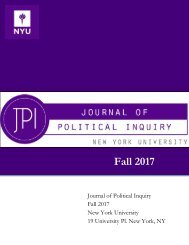JPI Spring 2018
You also want an ePaper? Increase the reach of your titles
YUMPU automatically turns print PDFs into web optimized ePapers that Google loves.
narratives and claims, incited distrust between ethnic factions. 58 The political map before the Ottoman<br />
arrival divided the Balkans in favor of the South Slavs which suggests to Serb and Croat nationalists<br />
that great kingdoms existed before the Ottoman occupation. While Venice governed most of Morea,<br />
the Byzantine Empire ruled from Constantinople to the northeast of Thessaloniki, Bulgaria controlled<br />
north of the Byzantine Empire up to the Danube, and the Kingdom of Serbia reigned over the rest<br />
of the Balkans up to the Kingdom of Hungary. 59 In 1355, the Serbian Kingdom experienced increased<br />
internal conflict, and in 1389, the Balkan princes allied to confront the Ottoman threat at the Battle<br />
of Kosovo. The battle’s legacy would become a central aspect of the Serbian identity. In the 1990s,<br />
Slobodan Milošević referenced it and Tsar Lazar’s 14 th -century sacrifice to defend Christianity and<br />
Europe from the invading Ottomans. 60 Similarly, the first President of the Republic of Croatia, Franjo<br />
Tuđman, emphasized the Croat national identity and articulated its centuries-old dream of<br />
independence from foreign rule, referencing the Kingdom of Croatia that existed from the 10 th to 12 th<br />
century. 61 Both leaders romanticized history to make irredentist claims and minimize the Bosniak<br />
identity for their respective interests. They increasingly reinterpreted historical facts rooted in medieval<br />
history to stir up nationalist fervor and reassert their own people as the dominant ethnic group of<br />
Bosnia. The breakdown of the Ottoman Empire allowed for the re-emergence of long-held territorial<br />
claims throughout the former Yugoslavia, and in Bosnia, specifically. During the Yugoslav wars, most<br />
ethnic cleansing and mass atrocities occurred in previously imperial contact zones inherited from the<br />
Ottoman Empire, with most violence taking place within Bosnia’s western and northern borders, the<br />
Habsburg military frontier in Croatia, and Kosovo. 62<br />
CONCLUSION<br />
In assessing the Ottoman legacy in Bosnia, it is essential to consider historical facts along with<br />
their interpreted meanings to understand the changing nature of cultural narratives. After the collapse<br />
of the Ottoman Empire, the ethnic groups of the Balkans became increasingly irredentist and<br />
dismissive of opposing historical accounts, which frequently resulted in aspirations for a greater Serbia<br />
or Croatia. Ironically, present-day Bosniak Muslims continue to share a state with Croats and Serbs, a<br />
polity in which many Serbs align with Serbia and a majority of Croats look to Croatia instead of viewing<br />
the Bosnian nation-state as their own.<br />
The perceived cultural narratives that propel conflict are traceable to Bosnia’s geographic<br />
positioning as a frontier state and its diverse demographic configuration. The Ottoman demographic<br />
influence charged proto-nationalist identities as conversions and migrations shifted between the cities<br />
and the countryside, and European ideas penetrated the minds of revolutionaries hoping to build<br />
homogenous nation-states. The scattered distributions of ethnic groups also prompted leaders to make<br />
irredentist claims, dismissing opposing narratives. Overwhelmed by the Ottoman legacy, the citizens<br />
of Višegrad experienced imperial pressures which stoked ethnic animosity for centuries, but learned<br />
to live side by side nonetheless, up until the disintegration of Yugoslavia in the 1990s.<br />
58<br />
Ibid.<br />
59<br />
Peter F. Sugar, Southeastern Europe under Ottoman Rule, 1354-1804, vol. 5 of A History of East Central Europe (Seattle: University of Washington Press,<br />
1977), 13-17.<br />
60<br />
Kerstin Carlson, “Model(ing) Law: The ICTY, the International Criminal Justice Template, and Reconciliation in the Former Yugoslavia,” UC<br />
Berkeley: Jurisprudence & Social Policy (2013): 60, eScholarship (accessed November 26, 2017).<br />
61<br />
Tamara Banjeglav, "Conflicting Memories, Competing Narratives and Contested Histories in Croatia's Post-war Commemorative Practices," Politicka<br />
Misao: Croatian Political Science Review 49, no. 5 (November 2012): 10, Academic Search Complete, EBSCOhost (accessed November 26, 2017).<br />
62<br />
A. Bebler, "Turkey's Imperial Legacy and the Potential for Conflict in the Balkans," Politicka Misao 53, no. 4 (March 1, 2017), 166, Scopus®,<br />
EBSCOhost (accessed November 20, 2017).<br />
<strong>JPI</strong> Fall 2017, pg. 16
















